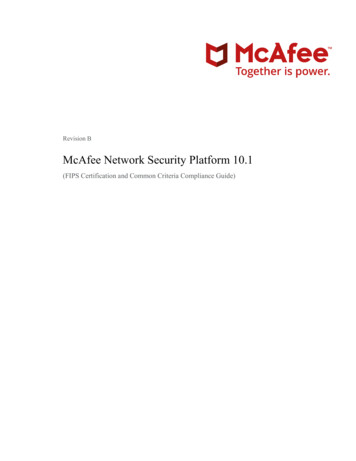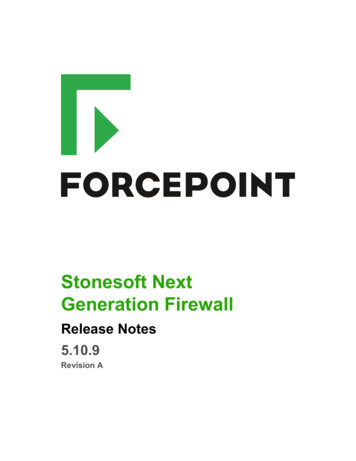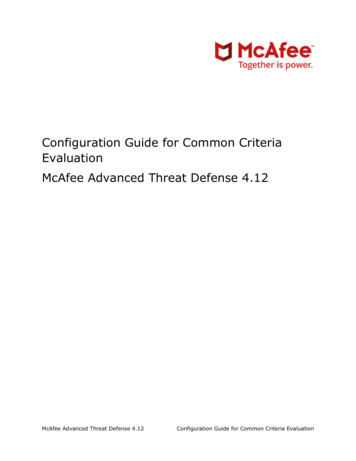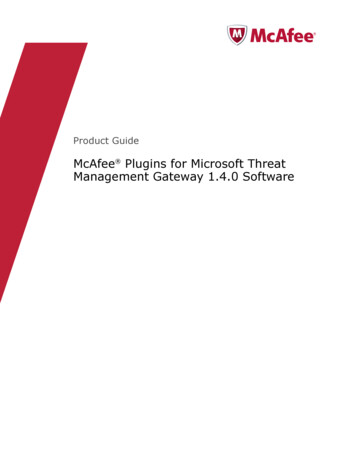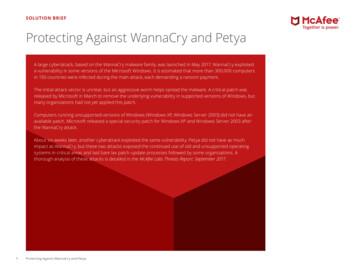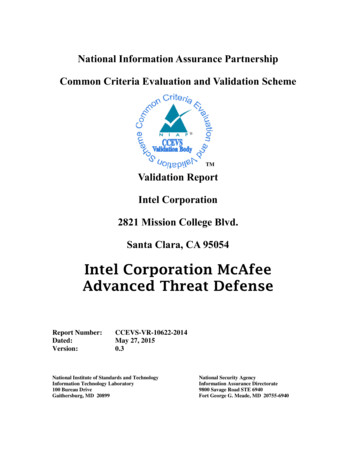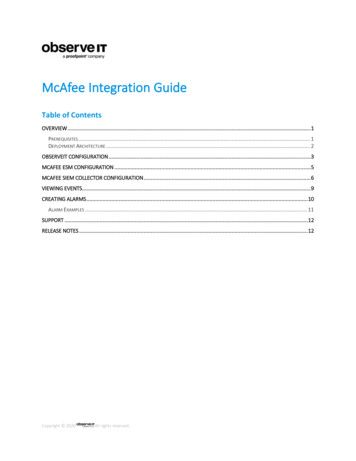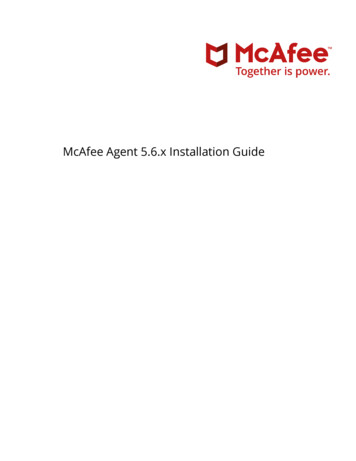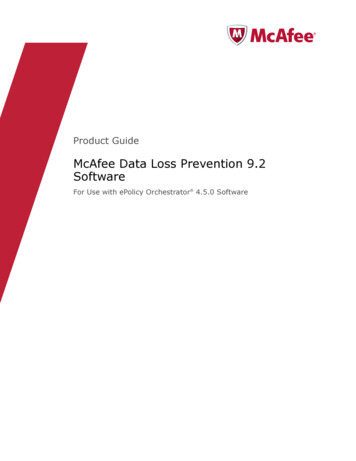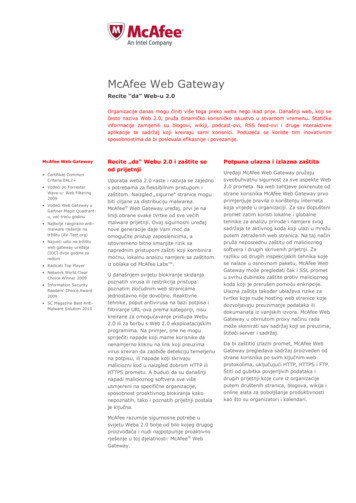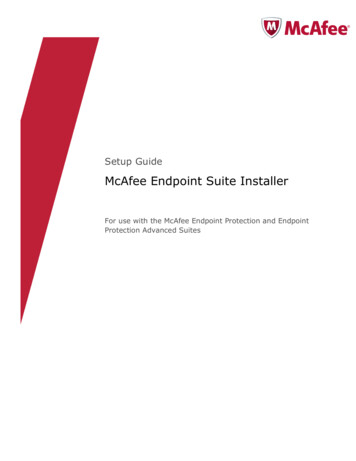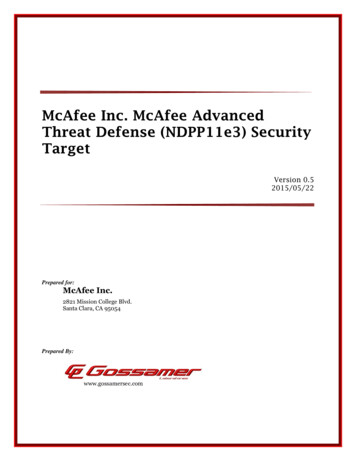
Transcription
McAfee Inc. McAfee AdvancedThreat Defense (NDPP11e3) SecurityTargetVersion 0.52015/05/22Prepared for:McAfee Inc.2821 Mission College Blvd.Santa Clara, CA 95054Prepared By:www.gossamersec.com
McAfee Inc. McAfee Advanced Threat Defense (NDPP11e3) Security Target1.Version 0.5, 2015/05/22SECURITY TARGET INTRODUCTION .31.1SECURITY TARGET REFERENCE .31.2TOE REFERENCE .41.3TOE OVERVIEW .41.4TOE DESCRIPTION .41.4.1TOE Architecture .41.4.2TOE Documentation . 62.CONFORMANCE CLAIMS . 72.13.CONFORMANCE RATIONALE .7SECURITY OBJECTIVES . 83.1SECURITY OBJECTIVES FOR THE OPERATIONAL ENVIRONMENT .84.EXTENDED COMPONENTS DEFINITION .95.SECURITY REQUIREMENTS . 105.1TOE SECURITY FUNCTIONAL REQUIREMENTS . 105.1.1Security audit (FAU) . 115.1.2Cryptographic support (FCS) . 115.1.3User data protection (FDP) . 135.1.4Identification and authentication (FIA) . 135.1.5Security management (FMT) . 145.1.6Protection of the TSF (FPT) . 145.1.7TOE access (FTA) . 155.1.8Trusted path/channels (FTP) . 155.2TOE SECURITY ASSURANCE REQUIREMENTS. 165.2.1Development (ADV) . 165.2.2Guidance documents (AGD) . 175.2.3Life-cycle support (ALC) . 185.2.4Tests (ATE) . 185.2.5Vulnerability assessment (AVA) . 186.TOE SUMMARY SPECIFICATION . 206.16.26.36.46.56.66.76.8SECURITY AUDIT . 20CRYPTOGRAPHIC SUPPORT . 21USER DATA PROTECTION . 23IDENTIFICATION AND AUTHENTICATION . 24SECURITY MANAGEMENT . 24PROTECTION OF THE TSF . 24TOE ACCESS. 25TRUSTED PATH/CHANNELS . 25LIST OF TABLESTable 1 TOE Security Functional Components . 11Table 2 EAL 1 Assurance Components . 16Table 3 Auditable Events . 21Table 4 Cryptographic Functions . 22Table 5 NIST SP800-56B Conformance . 23Page 2 of 25
McAfee Inc. McAfee Advanced Threat Defense (NDPP11e3) Security TargetVersion 0.5, 2015/05/221. Security Target IntroductionThis section identifies the Security Target (ST) and Target of Evaluation (TOE) identification, ST conventions, STconformance claims, and the ST organization. The TOE is McAfee Advanced Threat Defense provided by McAfeeInc. The TOE is being evaluated as a network infrastructure device.The Security Target contains the following additional sections: Conformance Claims (Section 2) Security Objectives (Section 3) Extended Components Definition (Section 4) Security Requirements (Section 5) TOE Summary Specification (Section 6)ConventionsThe following conventions have been applied in this document: Security Functional Requirements – Part 2 of the CC defines the approved set of operations that may beapplied to functional requirements: iteration, assignment, selection, and refinement.oIteration: allows a component to be used more than once with varying operations. In the ST,iteration is indicated by a letter placed at the end of the component. For example FDP ACC.1aand FDP ACC.1b indicate that the ST includes two iterations of the FDP ACC.1 requirement, aand b.oAssignment: allows the specification of an identified parameter. Assignments are indicated usingbold and are surrounded by brackets (e.g., [assignment]). Note that an assignment within aselection would be identified in italics and with embedded bold brackets (e.g., [[selectedassignment]]).oSelection: allows the specification of one or more elements from a list. Selections are indicatedusing bold italics and are surrounded by brackets (e.g., [selection]).oRefinement: allows the addition of details. Refinements are indicated using bold, for additions,and strike-through, for deletions (e.g., “ all objects ” or “ some big things ”). The NDPP uses an additional convention – the ‘case’ – which defines parts of an SFR that apply only whencorresponding selections are made or some other identified conditions exist. Only the applicable cases areidentified in this ST and they are identified using bold text. Other sections of the ST – Other sections of the ST use bolding to highlight text of special interest, such ascaptions.1.1 Security Target ReferenceST Title – McAfee Inc. McAfee Advanced Threat Defense (NDPP11e3) Security TargetST Version – Version 0.5ST Date – 2015/05/22Page 3 of 25
McAfee Inc. McAfee Advanced Threat Defense (NDPP11e3) Security TargetVersion 0.5, 2015/05/221.2 TOE ReferenceTOE Identification – McAfee Inc. McAfee Advanced Threat Defense models 3000 and 6000 running softwareversion 3.4.6TOE Developer – McAfee Inc.Evaluation Sponsor – McAfee Inc.1.3 TOE OverviewThe Target of Evaluation (TOE) is McAfee Advanced Threat Defense (MATD). MATD detects today’s stealthy,zero-day malware with layered approach. It combines low-touch antivirus signatures, reputation, and real-timeemulation defenses with in-depth static code and dynamic analysis (sandboxing) to analyze actual behavior.1.4 TOE DescriptionThe MATD hardware appliance implements dynamic and statistical analysis on data transmitted through a networkto provide malware detection, assessment and classification.The MATD processes the files through the down selectors for statistical analysis and provides a sandbox testenvironment which includes virtual machines running customer environments, anti-virus, anti-malware, localblacklist and whitelists. Files are executed within virtual machine environments that are monitored by the log file.The log file is then used to generate a security report of the potential malware.For the purpose of evaluation, MATD will be treated as a network device offering FIPS certified cryptographicfunctions, security auditing, secure administration, trusted updates, self-tests, and secure connections to other servers(e.g., to transmit audit records).1.4.1 TOE ArchitectureMATD is provided as a hardware network appliance. The product provides a web interface over TLS and a consoleconnection.There are two versions of the MATD product (6000 and 3000). While there are different models in the TOE, theydiffer primarily in physical form factor, number and types of connections and slots, and relative performance. Thereare some functional differences among the models, but they each provide the same security characteristics asclaimed in this security target.1.4.1.1 Physical BoundariesThe ATD evaluated configuration includes software version 3.4.6 running on one of the following modules: ATD-6000: McAfee Advanced Threat Defense 6000, 2U 4x Xeon E5-4640 (2.5GHz), 256GB DDR3,16TB of HDD storage and 1600MB of SSD storage. ATD-3000: McAfee Advanced Treat Defense 3000, 1U 2x Xeon E5-2658 (2.1GHz), 192GB DDR3, 8TBof HDD storage and 800MB of SSD storage.Since each platform uses the same software and the TOE implements all provided security functions in software, theTOE security behavior remains equivalent on each platform for each of the SFRs defined by the NDPP11e3. TheseSFRs are instantiated by the same version of the TOE software and in the same way on both platforms. Bothplatforms have Intel Xeon 64-bit CPUs. Both platforms utilize Linux 3.10.45 and OpenSSL FIPS Object Module2.0.5, hence the identical software (version 3.4.6) operates on both platforms. The differences simply relate toperformance – number of CPUs and amount of memory and HD/SSD storageThe TOE may be accessed and managed through a PC or terminal in the environment which can be remote from ordirectly connected to the TOE.Page 4 of 25
McAfee Inc. McAfee Advanced Threat Defense (NDPP11e3) Security TargetVersion 0.5, 2015/05/22The TOE can be configured to forward its audit records to an external syslog server in the network environment.This is generally advisable given the limited audit log storage space on the evaluated appliances.The TOE can be configured to synchronize its internal clock using an external NTP server in the operationalenvironment.1.4.1.2 Logical BoundariesThis section summarizes the security functions provided by MATD:- Security audit- Cryptographic support- User data protection- Identification and authentication- Security management- Protection of the TSF- TOE access- Trusted path/channels1.4.1.2.1 Security auditThe TOE generates audit events associated with identification and authentication, management, updates, and usersessions. The TOE can store the events in a local log or export them to a syslog server using a TLS protectedchannel.1.4.1.2.2 Cryptographic supportThe TOE provides CAVP certified cryptography in support of its TLS implementation. Cryptographic servicesinclude key management, random bit generation, encryption/decryption, digital signature and secure hashing.1.4.1.2.3 User data protectionThe TOE ensures that residual information is protected from potential reuse in accessible objects such as networkpackets.1.4.1.2.4 Identification and authenticationThe TOE requires users to be identified and authenticated before they can use functions mediated by the TOE, withthe exception of reading the login banner. It provides the ability to both assign attributes (user names, passwordsand roles) and to authenticate users against these attributes.1.4.1.2.5 Security managementThe TOE provides a command line (CLI) management interface as well as a graphical user interface (GUI) accessedvia the web. The web interface is protected with TLS. The management interface is limited to the authorizedadministrator (as defined by a role).1.4.1.2.6 Protection of the TSFThe TOE provides a variety of means of protecting itself. The TOE performs self-tests that cover the correctoperation of the TOE. It provides functions necessary to securely update the TOE. It provides a hardware clock toensure reliable timestamps. It protects sensitive data such as stored passwords and cryptographic keys so that theyare not accessible even by an authorized administrator.1.4.1.2.7 TOE accessThe TOE can be configured to display a logon banner before a user session is established. The TOE also enforcesinactivity timeouts for local and remote sessions.Page 5 of 25
McAfee Inc. McAfee Advanced Threat Defense (NDPP11e3) Security TargetVersion 0.5, 2015/05/221.4.1.2.8 Trusted path/channelsThe TOE provides a local console which is subject to physical protection. For remote access, the web GUI isprotected by TLS thus ensuring protection against modification and disclosure.The TOE also protects its audit records from modification and disclosure by using TLS to communicate with thesyslog server.1.4.2 TOE DocumentationMcAfee offers a series of documents that describe the installation of the MATD as well as guidance for subsequentuse and administration of the applicable security features. The following list of documents was examined as part ofthe evaluation: NDPP Admin Guide, v 0.3, 4/27/15 ATD 3.4.6 Product Guide, Revision APage 6 of 25
McAfee Inc. McAfee Advanced Threat Defense (NDPP11e3) Security TargetVersion 0.5, 2015/05/222. Conformance ClaimsThis TOE is conformant to the following CC specifications: Common Criteria for Information Technology Security Evaluation Part 2: Security functional components,Version 3.1, Revision 4, September 2012. Part 2 ExtendedCommon Criteria for Information Technology Security Evaluation Part 3: Security assurance components,Version 3.1 Revision 4, September 2012. Part 3 Conformant Protection Profile for Network Devices, Version 1.1 (with Errata #3), 8 June 2012 (NDPP11e3) Package Claims: Assurance Level: EAL 1 conformant2.1 Conformance RationaleThe ST conforms to the NDPP11e3. As explained previously, the security problem definition, security objectives,and security requirements have been drawn from the PP.Page 7 of 25
McAfee Inc. McAfee Advanced Threat Defense (NDPP11e3) Security TargetVersion 0.5, 2015/05/223. Security ObjectivesThe Security Problem Definition may be found in the NDPP11e3 and this section reproduces only the correspondingSecurity Objectives for operational environment for reader convenience. The NDPP11e3 offers additionalinformation about the identified security objectives, but that has not been reproduced here and the NDPP11e3 shouldbe consulted if there is interest in that material.In general, the NDPP11e3 has defined Security Objectives appropriate for network infrastructure device and as suchare applicable to the McAfee Advanced Threat Defense TOE.3.1 Security Objectives for the Operational EnvironmentOE.NO GENERAL PURPOSE There are no general-purpose computing capabilities (e.g., compilers oruser applications) available on the TOE, other than those services necessary for the operation,administration and support of the TOE.OE.PHYSICAL Physical security, commensurate with the value of the TOE and the data it contains, isprovided by the environment.OE.TRUSTED ADMIN TOE Administrators are trusted to follow and apply all administrator guidance in atrusted manner.Page 8 of 25
McAfee Inc. McAfee Advanced Threat Defense (NDPP11e3) Security TargetVersion 0.5, 2015/05/224. Extended Components DefinitionAll of the extended requirements in this ST have been drawn from the NDPP11e3. The NDPP11e3 defines thefollowing extended requirements and since they are not redefined in this ST the NDPP11e3 should be consulted formore information in regard to those CC extensions.Extended SFRs:- FAU STG EXT.1: External Audit Trail Storage- FCS CKM EXT.4: Cryptographic Key Zeroization- FCS RBG EXT.1: Extended: Cryptographic Operation (Random Bit Generation)- FCS TLS EXT.1: Explicit: TLS- FIA PMG EXT.1: Password Management- FIA UAU EXT.2: Extended: Password-based Authentication Mechanism- FIA UIA EXT.1: User Identification and Authentication- FPT APW EXT.1: Extended: Protection of Administrator Passwords- FPT SKP EXT.1: Extended: Protection of TSF Data (for reading of all symmetric keys)- FPT TST EXT.1: TSF Testing- FPT TUD EXT.1: Extended: Trusted Update- FTA SSL EXT.1: TSF-initiated Session LockingPage 9 of 25
McAfee Inc. McAfee Advanced Threat Defense (NDPP11e3) Security TargetVersion 0.5, 2015/05/225. Security RequirementsThis section defines the Security Functional Requirements (SFRs) and Security Assurance Requirements (SARs)that serve to represent the security functional claims for the Target of Evaluation (TOE) and to scope the evaluationeffort.The SFRs have all been drawn from the NDPP11e3. The refinements and operations already performed in theNDPP11e3 are not identified (e.g., highlighted) here, rather the requirements have been copied from the NDPP11e3and any residual operations have been completed herein. Of particular note, the NDPP11e3 made a number ofrefinements and completed some of the SFR operations defined in the Common Criteria (CC) and that PP should beconsulted to identify those changes if necessary.The SARs are also drawn from the NDPP11e3 which includes all the SARs for EAL 1. However, the SARs areeffectively refined since requirement-specific 'Assurance Activities' are defined in the NDPP11e3 that serve toensure corresponding evaluations will yield more practical and consistent assurance than the EAL 1 assurancerequirements alone. The NDPP11e3 should be consulted for the assurance activity definitions.5.1 TOE Security Functional RequirementsThe following table identifies the SFRs that are satisfied by McAfee Advanced Threat Defense TOE.Requirement ClassFAU: Security auditFCS: Cryptographic supportFDP: User data protectionFIA: Identification andauthenticationFMT: Security managementFPT: Protection of the TSFRequirement ComponentFAU GEN.1: Audit Data GenerationFAU GEN.2: User Identity AssociationFAU STG EXT.1: External Audit Trail StorageFCS CKM.1: Cryptographic Key Generation (for asymmetric keys)FCS CKM EXT.4: Cryptographic Key ZeroizationFCS COP.1(1): Cryptographic Operation (for dataencryption/decryption)FCS COP.1(2): Cryptographic Operation (for cryptographicsignature)FCS COP.1(3): Cryptographic Operation (for cryptographic hashing)FCS COP.1(4): Cryptographic Operation (for keyed-hash messageauthentication)FCS RBG EXT.1: Extended: Cryptographic Operation (Random BitGeneration)FCS TLS EXT.1: Explicit: TLSFDP RIP.2: Full Residual Information ProtectionFIA PMG EXT.1: Password ManagementFIA UAU.7: Protected Authentication FeedbackFIA UAU EXT.2: Extended: Password-based AuthenticationMechanismFIA UIA EXT.1: User Identification and AuthenticationFMT MTD.1: Management of TSF Data (for general TSF data)FMT SMF.1: Specification of Management FunctionsFMT SMR.2: Restrictions on Security RolesFPT APW EXT.1: Extended: Protection of Administrator PasswordsFPT SKP EXT.1: Extended: Protection of TSF Data (for reading ofall symmetric keys)FPT STM.1: Reliable Time StampsFPT TST EXT.1: TSF TestingPage 10 of 25
McAfee Inc. McAfee Advanced Threat Defense (NDPP11e3) Security TargetFTA: TOE accessFTP: Trusted path/channelsVersion 0.5, 2015/05/22FPT TUD EXT.1: Extended: Trusted UpdateFTA SSL.3: TSF-initiated TerminationFTA SSL.4: User-initiated TerminationFTA SSL EXT.1: TSF-initiated Session LockingFTA TAB.1: Default TOE Access BannersFTP ITC.1: Inter-TSF trusted channelFTP TRP.1: Trusted PathTable 1 TOE Security Functional Components5.1.1 Security audit (FAU)5.1.1.1 Audit Data Generation (FAU GEN.1)FAU GEN.1.1The TSF shall be able to generate an audit record of the following auditable events:a) Start-up and shut-down of the audit functions;b) All auditable events for the not specified level of audit; andc) All administrative actions;d) Specifically defined auditable events listed in Table 1 (in the NDPP).FAU GEN.1.2The TSF shall record within each audit record at least the following information:a) Date and time of the event, type of event, subject identity, and the outcome (success or failure)of the event; andb) For each audit event type, based on the auditable event definitions of the functional componentsincluded in the PP/ST, information specified in column three of Table 1 (in the NDPP).5.1.1.2 User Identity Association (FAU GEN.2)FAU GEN.2.1For audit events resulting from actions of identified users, the TSF shall be able to associate eachauditable event with the identity of the user that caused the event.5.1.1.3 External Audit Trail Storage (FAU STG EXT.1)FAU STG EXT.1.1The TSF shall be able to [transmit the generated audit data to an external IT entity] using atrusted channel implementing the [TLS] protocol.5.1.2 Cryptographic support (FCS)5.1.2.1 Cryptographic Key Generation (for asymmetric keys) (FCS CKM.1)FCS CKM.1.1Refinement: The TSF shall generate asymmetric cryptographic keys used for key establishment inaccordance with [ NIST Special Publication 800-56B, 'Recommendation for Pair-Wise KeyEstablishment Schemes Using Integer Factorization Cryptography' for RSA-basedkey establishment schemes]and specified cryptographic key sizes equivalent to, or greater than, a symmetric key strength of112 bits.Page 11 of 25
McAfee Inc. McAfee Advanced Threat Defense (NDPP11e3) Security TargetVersion 0.5, 2015/05/225.1.2.2 Cryptographic Key Zeroization (FCS CKM EXT.4)FCS CKM EXT.4.1The TSF shall zeroize all plaintext secret and private cryptographic keys and CSPs when no longerrequired.5.1.2.3 Cryptographic Operation (for data encryption/decryption) (FCS COP.1(1))FCS COP.1(1).1Refinement: The TSF shall perform encryption and decryption in accordance with a specifiedcryptographic algorithm AES operating in [CBC, GCM] and cryptographic key sizes 128-bits and256-bits that meets the following: FIPS PUB 197, 'Advanced Encryption Standard (AES)' [NIST SP 800-38A, NIST SP 800-38D]5.1.2.4 Cryptographic Operation (for cryptographic signature) (FCS COP.1(2))FCS COP.1(2).1Refinement: The TSF shall perform cryptographic signature services in accordance with a(2) RSA Digital Signature Algorithm (rDSA) with a key size (modulus) of 2048 bits or greater]that meets the following:[RSA Digital Signature Algorithm - FIPS PUB 186-2, 'Digital Signature Standard'].5.1.2.5 Cryptographic Operation (for cryptographic hashing) (FCS COP.1(3))FCS COP.1(3).1Refinement: The TSF shall perform cryptographic hashing services in accordance with a specifiedcryptographic algorithm [SHA-1, SHA-256, SHA-384, SHA-512] and message digest sizes [160,256, 384, 512] bits that meet the following: FIPS Pub 180-3, 'Secure Hash Standard.'5.1.2.6 Cryptographic Operation (for keyed-hash message authentication) (FCS COP.1(4))FCS COP.1(4).1Refinement: The TSF shall perform keyed-hash message authentication in accordance with aspecified cryptographic algorithm HMAC-[SHA-1], key size [equal to the input block size], andmessage digest sizes [160] bits that meet the following: FIPS Pub 198-1, 'The Keyed-HashMessage Authentication Code', and FIPS Pub 180-3, 'Secure Hash Standard.'5.1.2.7 Extended: Cryptographic Operation (Random Bit Generation) (FCS RBG EXT.1)FCS RBG EXT.1.1The TSF shall perform all random bit generation (RBG) services in accordance with [NISTSpecial Publication 800-90 using [CTR DRBG (AES-256)]] seeded by an entropy source thataccumulated entropy from [a software-based noise source].FCS RBG EXT.1.2The deterministic RBG shall be seeded with a minimum of [256 bits] of entropy at least equal tothe greatest security strength of the keys and hashes that it will generate.5.1.2.8 Explicit: TLS (FCS TLS EXT.1)FCS TLS EXT.1.1The TSF shall implement one or more of the following protocols [TLS 1.1 (RFC 4346), TLS 1.2(RFC 5246)] supporting the following ciphersuites:Mandatory Ciphersuites:TLS RSA WITH AES 128 CBC SHA,Optional Ciphersuites:Page 12 of 25
McAfee Inc. McAfee Advanced Threat Defense (NDPP11e3) Security TargetVersion 0.5, 2015/05/22[TLS RSA WITH AES 256 CBC SHA,TLS DHE RSA WITH AES 128 CBC SHA,TLS DHE RSA WITH AES 256 CBC SHA,TLS RSA WITH AES 128 CBC SHA256,TLS RSA WITH AES 256 CBC SHA256,TLS DHE RSA WITH AES 128 CBC SHA256,TLS DHE RSA WITH AES 256 CBC SHA256,TLS ECDHE RSA WITH RSA 128 CBC SHA256,TLS ECDHE RSA WITH RSA 256 CBC SHA384,TLS ECDHE RSA WITH RSA 128 GCM SHA256,TLS ECDHE RSA WITH RSA 256 GCM SHA384].5.1.3 User data protection (FDP)5.1.3.1 Full Residual Information Protection (FDP RIP.2)FDP RIP.2.1The TSF shall ensure that any previous information content of a resource is made unavailableupon the [allocation of the resource to] all objects.5.1.4 Identification and authentication (FIA)5.1.4.1 Password Management (FIA PMG EXT.1)FIA PMG EXT.1.1The TSF shall provide the following password management capabilities for administrativepasswords:1. Passwords shall be able to be composed of any combination of upper and lower case letters,numbers, and special characters: [!, @, #, , %, , &, *, (, )];2. Minimum password length shall settable by the Security Administrator, and support passwordsof 15 characters or greater.5.1.4.2 Protected Authentication Feedback (FIA UAU.7)FIA UAU.7.1The TSF shall provide only obscured feedback to the administrative user while the authenticationis in progress at the local console.5.1.4.3 Extended: Password-based Authentication Mechanism (FIA UAU EXT.2)FIA UAU EXT.2.1The TSF shall provide a local password-based authentication mechanism, [none] to performadministrative user authentication.5.1.4.4 User Identification and Authentication (FIA UIA EXT.1)FIA UIA EXT.1.1The TSF shall allow the following actions prior to requiring the non-TOE entity to initiate theidentification and authentication process:- Display the warning banner in accordance with FTA TAB.1;- [no other actions].FIA UIA EXT.1.2The TSF shall require each administrative user to be successfully identified and authenticatedbefore allowing any other TSF-mediated actions on behalf of that administrative user.Page 13 of 25
McAfee Inc. McAfee Advanced Threat Defense (NDPP11e3) Security TargetVersion 0.5, 2015/05/225.1.5 Security management (FMT)5.1.5.1 Management of TSF Data (for general TSF data) (FMT MTD.1)FMT MTD.1.1The TSF shall restrict the ability to manage the TSF data to the Security Administrators.5.1.5.2 Specification of Management Functions (FMT SMF.1)FMT SMF.1.1The TSF shall be capable of performing the following management functions:- Ability to administer the TOE locally and remotely;- Ability to update the TOE, and to verify the updates using [digital signature] capability prior toinstalling those updates;- [- Ability to configure the list of TOE-provided services available before an entity is identifiedand authenticated, as specified in FIA UIA EXT.1,- Ability to configure the cryptographic functionality].5.1.5.3 Restrictions on Security Roles (FMT SMR.2)FMT SMR.2.1The TSF shall maintain the roles: Authorized Administrator.FMT SMR.2.2The TSF shall be able to associate users with roles.FMT SMR.2.3The TSF shall ensure that the conditions- Authorized Administrator role shall be able to administer the TOE locally;- Authorized Administrator role shall be able to administer the TOE remotely;are satisfied5.1.6 Protection of the TSF (FPT)5.1.6.1 Extended: Protection of Administrator Passwords (FPT APW EXT.1)FPT APW EXT.1.1The TSF shall store passwords in non-plaintext form.FPT APW EXT.1.2The TSF shall prevent the reading of plaintext passwords.5.1.6.2 Extended: Protection of TSF Data (for reading of all symmetric keys) (FPT SKP EXT.1)FPT SKP EXT.1.1The TSF shall prevent reading of all pre-shared keys, symmetric keys, and private keys.5.1.6.3 Reliable Time Stamps (FPT STM.1)FPT STM.1.1The TSF shall be able to provide reliable time stamps for its o
The Target of Evaluation (TOE) is McAfee Advanced Threat Defense (MATD). MATD detects today's stealthy, zero-day malware with layered approach. It combines low-touch antivirus signatures, reputation, and real-time emulation defenses with in-depth static code and dynamic analysis (sandboxing) to analyze actual behavior. .
